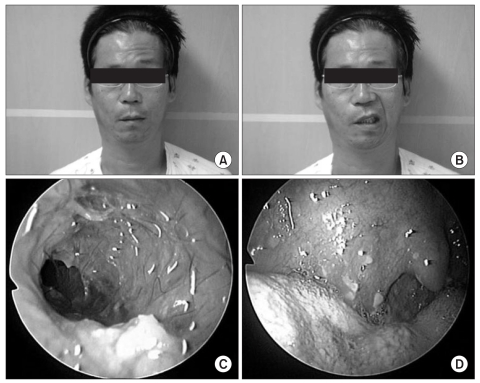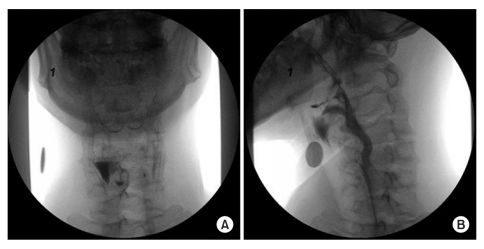Ann Rehabil Med.
2011 Oct;35(5):738-741. 10.5535/arm.2011.35.5.738.
Dysphagia in Ramsay Hunt's Syndrome: A Case Report
- Affiliations
-
- 1Department of Physical Medicine and Rehabilitation, College of Medicine, Dongguk University, Goyang 410-773, Korea. jinwoo.park.md@gmail.com
- KMID: 2267239
- DOI: http://doi.org/10.5535/arm.2011.35.5.738
Abstract
- Ramsay-Hunt syndrome is caused by varicella zoster virus infection in the geniculate ganglion of the facial nerve. It is characterized by facial palsy, otic pain, and herpetic vesicles around the auricle and external auditory canal. Additionally, symptoms may develop related to other cranial nerve involvement, such as dizziness or hearing loss by the vestibulocochlear nerve being invaded. We report a rare case of a Ramsay-Hunt syndrome patient who developed dysphagia due to multiple cranial nerve involvement including the glossopharyngeal nerve and vagus nerve.
Keyword
MeSH Terms
Figure
Reference
-
1. Sweeney CJ, Gilden DH. Ramsay Hunt syndrome. J Neurol Neurosurg Psychiatr. 2001; 71:149–154. PMID: 11459884.2. Tschiassny K. Herpes zoster oticus (Ramsay Hunt's syndrome) comments on an article by Johnson and Zonderman. Arch Otolaryngol. 1950; 51:73–82. PMID: 15408839.
Article3. Tanaka S, Mizukami S. Vagal communicating branches between the facial and glossopharyngeal nerves, with references to their occurrence from the embryological point of view. Acta Anat (Basel). 1991; 142:25–32. PMID: 1781236.
Article4. Lapresle J, Lasjaunias P. Cranial nerve ischaemic arterial syndromes. A review. Brain. 1986; 109:207–216. PMID: 3942855.5. Kleinschmidt-DeMasters BK, Amlie-Lefond C, Gilden DH. The patterns of varicella zoster virus encephalitis. Human Pathology. 1996; 27:927–938. PMID: 8816888.
Article6. Kinishi M, Amatsu M, Mohri M, Saito M, Hasegawa T, Hasegawa S. Acyclovir improves recovery rate of facial nerve palsy in Ramsay Hunt syndrome. Auris Nasus Larynx. 2001; 28:223–226. PMID: 11489365.
Article7. Murakami S, Hato N, Horiuchi J, Honda N, Gyo K, Yanagihara N. Treatment of Ramsay Hunt syndrome with acyclovir-prednisolone: significance of early diagnosis and treatment. Ann Neurol. 1997; 41:353–357. PMID: 9066356.8. Uri N, Greenberg E, Kitzes-Cohen R, Doweck I. Acyclovir in the treatment of Ramsay Hunt syndrome. Otolaryngol Head Neck Surg. 2003; 129:379–381. PMID: 14574292.
Article9. Robillard RB, Hilsinger RL Jr, Adour KK. Ramsay Hunt facial paralysis: clinical analysis of 185 patients. Otolaryngol Head Neck Surg. 1986; 95:292–297. PMID: 3108776.10. Logemann JA, Kahrilas PJ, Kobara M, Vakil NB. The benefit of head rotation on pharyngoesophageal dysphagia. Arch Phys Med Rehabil. 1989; 70:767–771. PMID: 2802957.
- Full Text Links
- Actions
-
Cited
- CITED
-
- Close
- Share
- Similar articles
-
- Ramsay Hunt syndrome
- Atypical Presentation of Acute Vestibular Syndrome with Ramsay Hunt Syndrome
- A Case of Ramsay Hunt Syndrome with Vocal Cord Paralysis
- A Case of Ramsay Hunt Syndrome Complicated with Multiple Cranial Nerve Palsy Followed by a Brain Stem Lesion
- Abducens Nerve Palsy Associated with Ramsay-Hunt Syndrome




